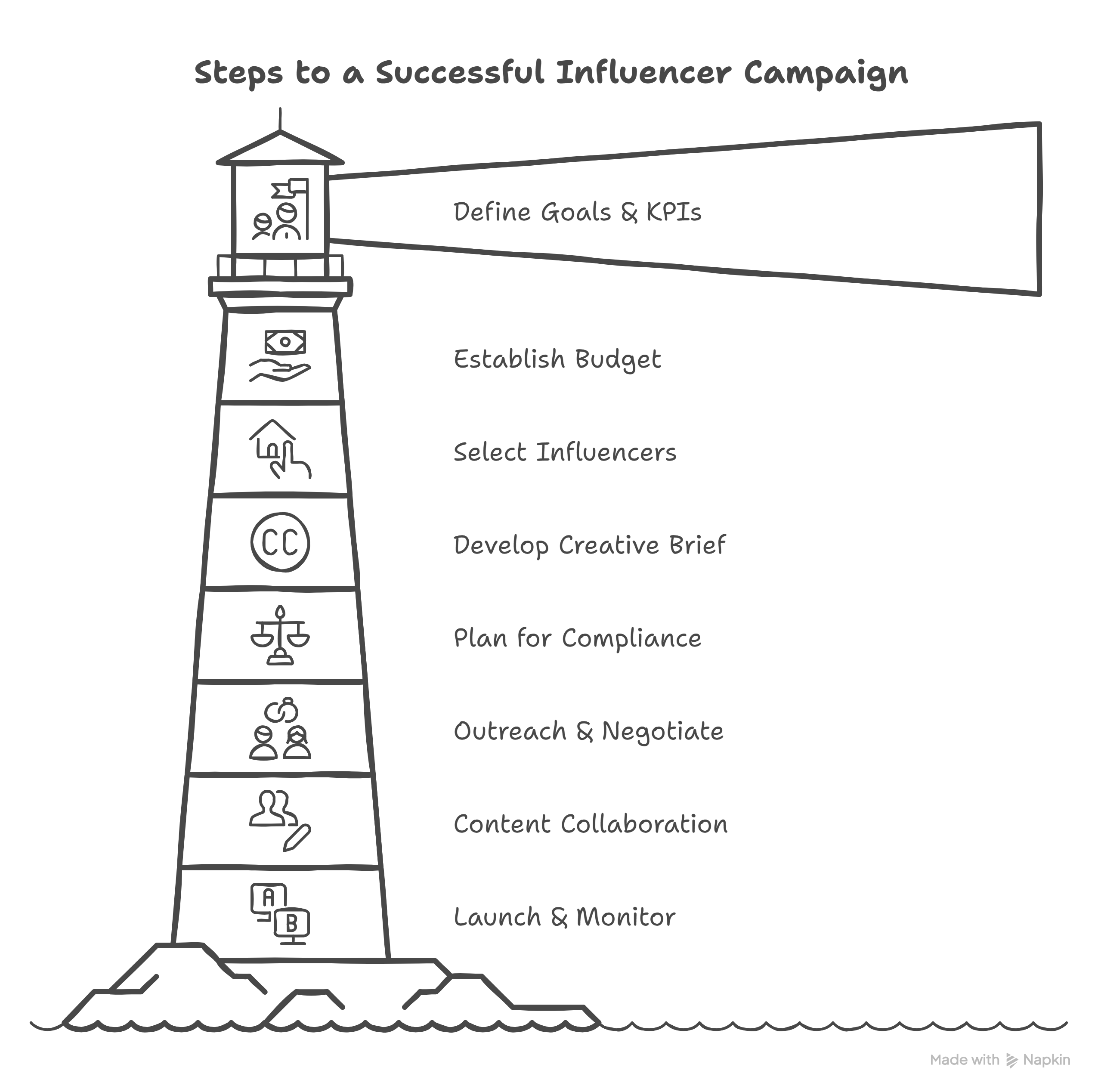Creating an Influencer Marketing Campaign
Launching a successful influencer marketing campaign involves careful planning and structured execution. Here’s a step-by-step guide:
Planning Phase: Laying the Groundwork
This initial stage is crucial for setting direction and ensuring alignment.
-
Define Goals & Key Performance Indicators (KPIs):
- Concept: Clearly determine what you want the campaign to achieve. Is it increased brand awareness, driving traffic to your website, generating direct sales, or collecting user-generated content (UGC)? Define specific, measurable metrics (KPIs) to track success. This aligns with the general marketing best practice of measuring results.
- Why it Matters: Without clear goals, you can't measure success or ROI. KPIs tell you if the campaign actually worked.
- Example: Instead of a vague goal like "increase awareness," a specific goal could be "Increase website traffic from Instagram by 15% within one month of the campaign launch" or "Generate 50 pieces of user-generated content using the campaign hashtag #MyBrandStyle."
-
Establish a Budget:
- Concept: Decide how much you can allocate to the campaign. Consider the influencer's fees, potential product costs (if gifting), agency fees (if using one), and any budget for amplifying the content. Determine the compensation model (e.g., flat fee per post, free product exchange, commission on sales generated).
- Why it Matters: Knowing your budget helps narrow down influencer choices and determines the scale of your campaign.
- Example: Setting a total budget of $5,000 allows you to decide if you can afford one macro-influencer demanding $4,000, or perhaps five micro-influencers at $800 each, plus $1,000 for product costs.
-
Select Influencers:
- Concept: Use the identification strategies discussed previously (audience alignment, relevance, reach, resonance, authenticity) to choose the best influencers for this specific campaign's goals and budget.
- Why it Matters: The right influencer is key to reaching the right audience effectively and authentically.
- Example: If your goal is direct sales for a new fitness app, you'd select fitness influencers with high engagement rates and a proven track record of driving conversions (e.g., through affiliate links), rather than just those with the largest following.
-
Develop a Creative Brief:
- Concept: Create a clear document outlining everything the influencer needs to know. Include the campaign concept, key messages to convey, specific deliverables (e.g., 1 Instagram Reel, 2 static posts, 5 Stories), content guidelines (dos and don'ts), posting timeline, and the desired Call-to-Action (e.g., "Use code INFLUENCER15 for 15% off," "Swipe up to learn more").
- Why it Matters: A detailed brief ensures the influencer understands expectations and creates content that aligns with your brand and campaign objectives, minimizing back-and-forth revisions.
- Example: The brief might specify: "Highlight the product's ease of use and eco-friendly packaging. Use natural lighting. Include a link to the product page in your bio for 48 hours. Mention the limited-time discount code 'ECOFRIENDLY'."
-
Plan for Legal Compliance & Disclosure:
- Concept: Ensure your campaign adheres to advertising regulations in your target regions. This typically involves clearly disclosing the paid partnership using hashtags like #ad, #sponsored, or platform-specific branded content tools. Plan for contracts outlining terms, usage rights, and payment schedules.
- Why it Matters: Non-disclosure can lead to legal trouble and damage trust with the audience. Clear contracts protect both the brand and the influencer.
- Example: Including a clause in the contract requiring the influencer to use the platform's 'Paid Partnership' tag and the #ad hashtag clearly and conspicuously at the beginning of the post caption or overlayed on video content.
Execution Phase: Bringing the Campaign to Life
This phase involves putting the plan into action.
-
Outreach & Negotiation:
- Concept: Reach out to your selected influencers using the personalized approach discussed earlier. Negotiate terms (compensation, deliverables, timeline) based on your budget and brief. Formalize the agreement with a signed contract.
- Why it Matters: Professional outreach sets the tone for the partnership. A contract solidifies expectations and protects both parties.
- Example: Sending the personalized outreach email, following up with a call if needed, discussing rates, agreeing on the number of posts and usage rights, and sending the contract for electronic signature.
-
Content Collaboration & Approval:
- Concept: Work collaboratively with the influencer as they create the content. Review drafts (if agreed upon in the contract) to ensure they meet the brief's guidelines and brand standards, while still allowing for the influencer's creative freedom and authenticity.
- Why it Matters: Collaboration ensures the final content is effective for the brand while remaining true to the influencer's voice, which resonates best with their audience.
- Example: The influencer sends a draft video for review. The brand provides feedback like, "Looks great! Could you make the logo on the product a bit more visible in the first 5 seconds?" without dictating the entire script.
-
Campaign Launch & Monitoring:
- Concept: The influencer publishes the content according to the agreed schedule. Monitor the posts as they go live, track initial engagement, respond to comments where appropriate, and ensure disclosures are correctly implemented.
- Why it Matters: Real-time monitoring allows you to catch any immediate issues and gauge initial audience reaction.
- Example: Setting up alerts for when the influencer posts, checking the engagement metrics (likes, comments, shares) within the first few hours, and noting down audience sentiment from the comments section.
-
Amplification (Optional but Recommended):
- Concept: Consider boosting the influencer's content through paid advertising on the platform or repurposing their content (with permission/rights secured in the contract) on your brand's own social media channels, website, or email newsletters.
- Why it Matters: Amplification extends the reach of the influencer's content beyond their organic following, maximizing the campaign's impact and ROI.
- Example: Using Facebook/Instagram ads manager to run the influencer's successful video post as an ad targeted to a lookalike audience, or sharing the influencer's positive review photo on the brand's official Instagram feed (tagging the influencer).


No Comments